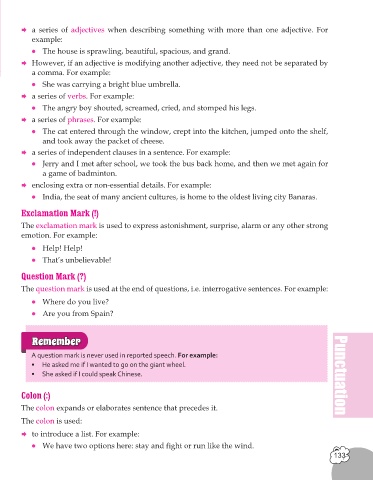Page 135 - English Grammar - 7
P. 135
� a series of adjectives when describing something with more than one adjective. For
example:
The house is sprawling, beautiful, spacious, and grand.
O
� However, if an adjective is modifying another adjective, they need not be separated by
a comma. For example:
She was carrying a bright blue umbrella.
O
� a series of verbs. For example:
The angry boy shouted, screamed, cried, and stomped his legs.
O
� a series of phrases. For example:
The cat entered through the window, crept into the kitchen, jumped onto the shelf,
O
and took away the packet of cheese.
� a series of independent clauses in a sentence. For example:
Jerry and I met after school, we took the bus back home, and then we met again for
O
a game of badminton.
� enclosing extra or non-essential details. For example:
India, the seat of many ancient cultures, is home to the oldest living city Banaras.
O
Exclamation Mark (!)
The exclamation mark is used to express astonishment, surprise, alarm or any other strong
emotion. For example:
Help! Help!
O
That’s unbelievable!
O
Question Mark (?)
The question mark is used at the end of questions, i.e. interrogative sentences. For example:
Where do you live?
O
Are you from Spain?
O
R
Rememberemember
A question mark is never used in reported speech. For example:
• He asked me if I wanted to go on the giant wheel.
• She asked if I could speak Chinese. Punctuation
Colon (:)
The colon expands or elaborates sentence that precedes it.
The colon is used:
� to introduce a list. For example:
We have two options here: stay and fight or run like the wind.
O
133

